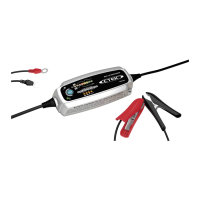9
electronics.
CTEK's chargers have a very 'pure' charge current and voltage, i.e., minimal ripple.
What aspects should I think about when choosing a
charger?
You should think about 3 things when choosing a charger:
1. How large the battery you want to charge is.
2. How discharged it will be before you get a chance to recharge it.
3. How quickly you need the battery to fully recharge.
If the battery is large, completely flat and must be charged quickly! Then you should choose
a powerful charger such as the Multi US 7002 or the Pro25S.
If you instead want to be sure that your motorcycle battery is charged and is kept charged
no matter whether you are going to use it tomorrow or in 6 months, then time is not so
important and a small charger will work well.
A CTEK charger is so small. How can it charge so quickly
and efficiently, when compared with ordinary chargers?
CTEK's chargers use the same type of technology that computers use to reduce dimensions,
to increase power and to charge using a well-controlled and 'pure' current. Also, think how
big mobile telephones were 15 years ago and how small they are today, and can even so do
so much more.
How much electrical energy does it take to charge a
lead-acid battery with a CTEK charger?
Here is an easy way to calculate the electrical energy expenditure when charging a lead-acid battery
with CTEK chargers.
Given:
Battery voltage, Bv = 12V
Battery size, Bs = 75Ah
The battery's charge level, Bl = 50%
The battery's efficiency level = 87%
CTEK charger's efficiency level = 80%
Calculate:
Energy consumed from the mains supply to fully charge the battery (En)
First, how much energy is needed to fill the battery?
12V x 75Ah x 50% = 12x75x0.5=450Wh
How much energy does the charger need to deliver based on the battery's efficiency level?
450Wh / 87% = 450/0.87 = 517Wh
How much energy does the mains supply deliver to the charger when taking the efficiency level into
consideration?
En = 517Wh / 80% =517 / 0.8 = 647Wh or 0,647kWh.
Answer:
0.647kWh is used to charge the battery based on the given data.

